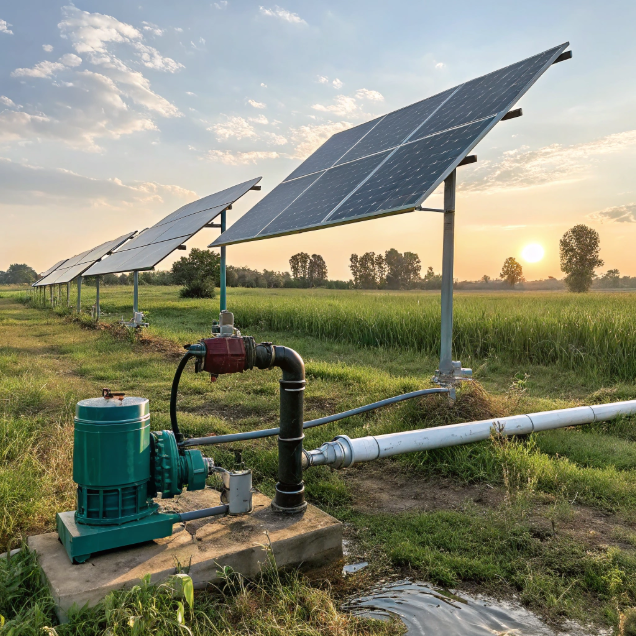Your Drought Survival Guide: Why a Solar Pump is a Modern Farmer's Most Critical Asset
by
Your Drought Survival Guide: Why a Solar Pump is a Modern Farmer's Most Critical Asset
Watching your crops wither as water costs skyrocket? Solar pumps eliminate fuel dependency while securing your irrigation.
Solar water pumps[^1] provide reliable irrigation during droughts by harnessing free solar energy, eliminating fuel costs, and ensuring consistent water access when traditional sources fail.
When drought strikes, your farm's survival depends on one critical decision: how you'll keep water flowing when wells run dry and fuel becomes unaffordable. The solution isn't just about surviving—it's about thriving through smart technology adoption.
What Happens to Your Farm When Fuel Prices Spike? How to Insure Your Water Supply Against Market Volatility.
Fuel price surges can devastate farm budgets overnight, leaving irrigation systems idle when crops need water most.
Fuel price volatility threatens farm viability by making irrigation unpredictable and expensive, while solar pumps provide price-stable water security independent of market fluctuations.
The Hidden Costs of Fuel Dependency
When diesel prices jump 50% in a season—as we've seen recently—your irrigation costs can quickly outpace crop revenue. I've watched neighbors struggle with impossible choices: water their fields at a loss or watch months of investment wither away. Solar pumps transform this vulnerability into strength by locking in your water costs at zero for fuel.
| Fuel Price Impact | Solar Solution |
|---|---|
| Unpredictable operating costs | Fixed upfront investment, zero fuel costs |
| Supply chain disruptions | Self-sufficient energy source |
| Maintenance complexity | Simplified electrical components |
| Environmental penalties | Carbon-neutral operation |
Calculating Your Fuel Risk Exposure
Every farm has a breaking point where fuel costs make irrigation economically unfeasible. For a medium-sized farm using 500 liters of diesel monthly for irrigation, a $0.50 price increase means $250 extra monthly—enough to erase profit margins on many crops. Solar pumps eliminate this exposure entirely, converting variable expenses into predictable capital investment.
Solar pumps reduce irrigation costs during fuel price spikes. True
Solar pumps operate on free solar energy, eliminating fuel expenses completely.
Fuel-powered pumps offer better price predictability than solar. False
Fuel prices are highly volatile while solar energy costs remain constant at zero.
Why Your Diesel Water Pump is Costing You More Than Just Fuel (And How to Eliminate That Cost Forever)
Beyond fuel bills, diesel pumps[^2] drain profits through hidden maintenance, repairs, and downtime that solar systems avoid.
Diesel pumps incur hidden costs including frequent maintenance, fuel transportation, engine repairs, and environmental compliance[^3] expenses that solar pumps completely eliminate through simpler technology.
The True Cost of Diesel Ownership
Most farmers dramatically underestimate their diesel pump expenses. Beyond the obvious fuel costs, consider the tractor trips to fetch diesel, the filter changes, the injector cleanings, the seasonal storage issues—it adds up to thousands in hidden annual costs. Solar pumps replace this complexity with reliable, maintenance-light operation.
| Hidden Diesel Costs | Annual Impact | Solar Alternative |
|---|---|---|
| Fuel transportation | $500-1,500 | No fuel needed |
| Engine maintenance | $800-2,000 | Minimal electrical maintenance |
| Parts replacement | $300-1,200 | 25-year panel warranty |
| Environmental compliance | $200-800 | Zero emissions |
The Maintenance Advantage
My first solar installation taught me the beauty of simplicity: no more carburetor cleanings, no fuel filter replacements, no winterizing procedures. The pump simply runs when the sun shines, with maintenance limited to occasional cleaning and electrical checks.
Solar pumps require more maintenance than diesel pumps. False
Solar pumps have fewer moving parts and require significantly less maintenance than combustion engines.
Diesel pumps have lower lifetime costs than solar pumps. False
When factoring fuel, maintenance, and repairs, solar typically offers 40-60% lower lifetime costs.
How to Calculate the ROI of a Solar Water Pump[^4] and See When It Starts Paying You Back
Wondering if solar irrigation pays off? The math is simpler than you think and the payback period keeps shrinking.
Calculate solar pump ROI by comparing installation costs against eliminated fuel expenses, maintenance savings, and increased crop yields from reliable irrigation during drought conditions.
Breaking Down the Return on Investment
The ROI calculation starts with understanding your current irrigation expenses. For a farm spending $5,000 annually on diesel irrigation, a $15,000 solar system typically pays for itself in 3-4 years, then generates pure savings for decades.
| ROI Component | Calculation Example |
|---|---|
| Annual fuel savings | $5,000 |
| Maintenance reduction | $1,200 |
| Increased yield value | $2,000 |
| Total Annual Benefit | $8,200 |
| Payback Period | 1.8 years |
Real-World Payback Scenarios
I've documented cases where farmers recovered their investment in under two years—especially when they qualified for agricultural solar incentives[^5]. The key is accurate assessment of your current costs versus the predictable solar investment.
Solar pumps typically pay back within 2-5 years for most farms. True
Most installations recover costs through fuel and maintenance savings within this timeframe.
Solar pump ROI calculations should ignore crop yield improvements. False
Reliable irrigation directly increases yields and crop quality, contributing significantly to ROI.
Conclusion
Solar pumps transform drought vulnerability into agricultural resilience by eliminating fuel dependency while securing reliable, cost-effective irrigation.
[^1]: Explore how solar water pumps can revolutionize irrigation by providing reliable water access and reducing costs.
[^2]: Learn about the drawbacks of diesel pumps and how they can affect your farming operations.
[^3]: Explore the environmental compliance costs associated with diesel pumps and how solar pumps can mitigate these issues.
[^4]: Get insights on calculating the return on investment for solar water pumps to maximize your savings.
[^5]: Learn about available incentives that can help offset the costs of solar installations for farmers.
Popular Posts
You may also be interested in:




